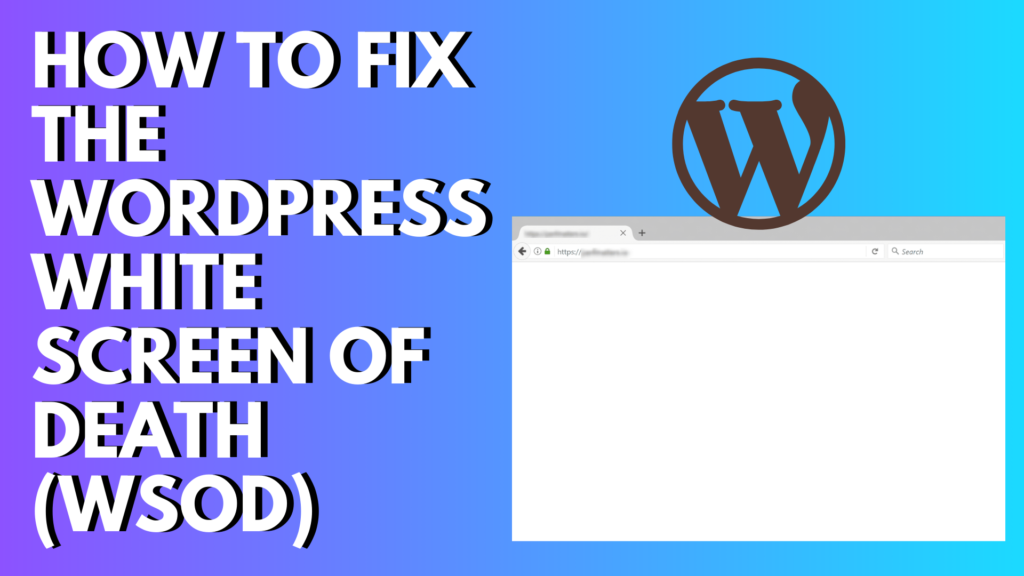
The WordPress White Screen of Death (WSOD) is one of the most frustrating errors a website owner can encounter. Instead of loading your site, you are met with a blank white screen with no error messages, making troubleshooting difficult.
In this guide, we will cover the common causes of WSOD and provide step-by-step solutions to help you get your website back online.
What Causes the WordPress White Screen of Death?
Several issues can trigger the WSOD, including:
- Exhausted PHP Memory Limit – When your website exceeds the allocated PHP memory, it may fail to load.
- Plugin Conflicts – A malfunctioning or incompatible plugin can break your site.
- Theme Issues – A problematic theme update or custom coding error can cause the white screen.
- Corrupt Core Files – A failed WordPress update or accidental file modification may corrupt essential files.
- Syntax Errors in Code – Mistakes in PHP files can lead to a blank screen.
Now, let’s go through solutions to fix the issue.
Solution 1: Increase PHP Memory Limit
If your WordPress installation exceeds its available memory, increasing the limit may resolve the problem.
Step 1: Access wp-config.php
- Log in to your hosting control panel or use an FTP client.
- Navigate to your WordPress root directory and locate
wp-config.php.
Step 2: Increase the Memory Limit
- Open
wp-config.phpand add the following line before the/* That's all, stop editing! Happy blogging. */comment:
define('WP_MEMORY_LIMIT', '256M');
Step 3: Save and Upload
- Save the changes and upload the modified file.
- Refresh your website to check if the issue is resolved.
Solution 2: Deactivate All Plugins
Since a faulty plugin can cause WSOD, deactivating all plugins can help identify the problem.
Step 1: Access Your WordPress Files
- Use FTP or File Manager from your hosting provider.
- Navigate to
wp-content/plugins.
Step 2: Rename the Plugins Folder
- Rename the
pluginsfolder toplugins_old. - This deactivates all plugins at once.
Step 3: Check Your Website
- If your site loads, the issue is related to a plugin.
- Rename the
plugins_oldfolder back toplugins. - Activate each plugin one by one to identify the problematic one.
Solution 3: Switch to a Default Theme
If the problem persists, your theme may be causing it.
Step 1: Access wp-content/themes
- Connect via FTP or File Manager.
- Navigate to
wp-content/themes.
Step 2: Rename the Active Theme Folder
- Rename your current theme folder (e.g.,
mytheme_old). - WordPress will automatically revert to a default theme like
Twenty Twenty-One.
Step 3: Check Your Site
- If your website loads, the issue lies with your previous theme.
- Update or reinstall the theme and check for errors.
Solution 4: Enable Debug Mode
Activating WordPress debugging can reveal hidden error messages that point to the cause of WSOD.
Step 1: Edit wp-config.php
- Open
wp-config.phpand add these lines before the/* That's all, stop editing! Happy blogging. */comment:
define('WP_DEBUG', true);
define('WP_DEBUG_LOG', true);
define('WP_DEBUG_DISPLAY', false);
@ini_set('display_errors', 0);
Step 2: Locate the Debug Log
- Find the
debug.logfile inside thewp-contentfolder. - Open it to identify the error messages and resolve them accordingly.
Solution 5: Restore from a Backup
If none of the above solutions work, restoring your site from a backup can be a quick fix.
Step 1: Check Your Hosting Backup
- Many hosting providers offer daily backups.
- Access your hosting panel and restore the latest stable version.
Step 2: Use a Backup Plugin
- If you have a backup plugin like UpdraftPlus or VaultPress, restore your latest backup.
Step 3: Test Your Site
- After restoration, verify that your site functions correctly.
- Update plugins/themes carefully to avoid future errors.
How to Fix WordPress White Screen of Death, WordPress WSOD troubleshooting guide, Fix WordPress blank screen error, WordPress white screen of death plugin conflict, Increase PHP memory limit WordPress WSOD, WordPress debug mode white screen of death, Disable plugins WordPress WSOD fix, WordPress recovery mode white screen, WordPress WSOD FTP solution, WordPress white screen of death long post fix, WordPress WSOD cache clearing tutorial, WordPress white screen of death theme conflict, WordPress WSOD file permissions fix, WordPress white screen of death backup restore, WordPress WSOD error logging tutorial
Preventing the White Screen of Death in the Future
Here are some best practices to prevent WSOD:
- Regular Backups: Always keep backups to restore your site quickly.
- Use Reliable Plugins and Themes: Avoid poorly coded or outdated plugins/themes.
- Keep WordPress Updated: Running the latest version ensures stability and security.
- Enable Debugging Early: Turning on WP_DEBUG in development helps catch errors before they break your site.
By following these steps, you can diagnose and fix the White Screen of Death and prevent it from occurring again in the future. If you need further help, reach out to the WordPress community or your hosting provider for support.
Need More Help?
If the issue persists after trying these solutions, consider seeking help from:
- Your hosting provider’s support team.
- The WordPress.org support forums.
- A professional WordPress developer.
Fixing the WSOD can be daunting, but with patience and the right approach, your site will be up and running in no time!
WordPress White Screen of Death fix
How to fix WordPress WSOD
Troubleshooting WordPress blank page
WordPress WSOD solution
Repair WordPress white screen error
WordPress blank screen troubleshooting
Resolving WordPress white screen issue
WordPress white page error fix
WordPress WSOD troubleshooting steps




0 Comments